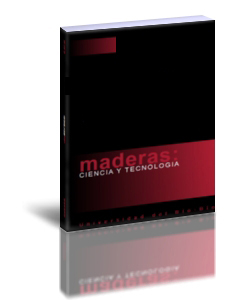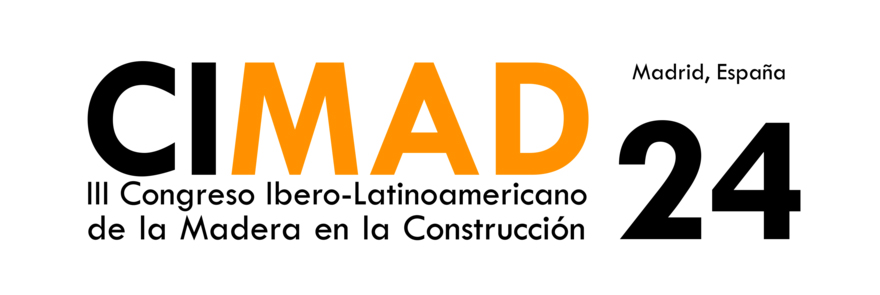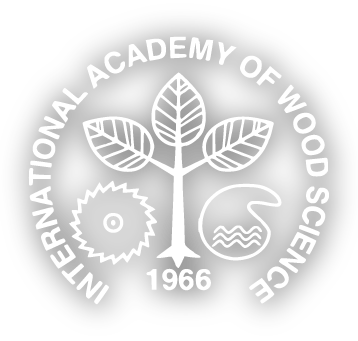Assessment of cellulose nanofibers from bolaina blanca wood obtained at three shaft heights
DOI:
https://doi.org/10.22320/s0718221x/2024.18Keywords:
Bolaina blanca, cellulose nanofibers, polimerization degree, Guazuma crinita, pulp treatmentAbstract
This study evaluated cellulose nanofibers from bolaina blanca wood (Guazuma crinita) obtained at different heights of the longitudinal axis of the shaft of trees from a three-and-a-half-year-old plantation. The wood was subjected to pulping, bleaching and subsequent mechanical milling using a Changsha Samy XYQM-2L planetary ball mill to obtain cellulose nanofibers. The product was characterised using analytical techniques: scanning electron microscopy, X-ray diffraction, thermogravimetric analysis, Fourier transform infrared spectroscopy, ultraviolet–visible spectroscopy. Additionally, the degree of polymerisation was determined. The effect of longitudinal position on cellulose nanofibers characteristics was evaluated by comparing means using ANOVA and Kruskal–Wallis statistical tests. The yield of cellulose nanofibers production from the high, middle and basal sections was 32,1 %, 33,6 % and 31 %, respectively. The obtained cellulose nanofibers exhibited a significantly larger diameter for the high zone (84 nm) compared with the middle (75 nm) and basal (69 nm) zones; the length remained above the micrometre range. With respect to degree of polymerisation, a decrease was evidenced with respect to the increase in shaft height; the basal zone exhibited a degree of polymerisation of 300, a significantly higher value than the middle and high zones, which exhibited degree of polymerisation of 249 and 211, respectively. The product showed typical cellulose type I polymorphism and crystallinity indexes of 76 %, 93 % and 96 % for the high, middle and basal sections, respectively. Regarding the thermostability of cellulose nanofibers, the maximum degradation rate of cellulose nanofibers occurred between 335 °C and 341 °C, with cellulose nanofibers from the basal area being the most stable. The adsorption of the methylene blue dye on cellulose nanofibers was evaluated; an efficiency > 60 % was found.
Downloads
References
Ahmad, A.; Alrozi, R. 2010. Optimization of preparation conditions for Mangosteen peel-based activated carbons for the removal of Remazol brilliant blue R using response surface methodology. Chemical Engineer- ing Journal 165(3): 883-890. https://doi.org/10.1016/j.cej.2010.10.049
ASTM. 2015. Standard test methods for proximate analysis of coal and coke by macro thermogravimetric analysis. ASTM D7582-15. ASTM International: West Conshohocken, Pensilvania, United States.
Bajpai, P. 2018. Chapter 12. Pulping Fundamentals. In: Handbook of pulp and paper (Third Ed.). Elsevier. https://doi.org/10.1016/B978-0-12-814240-0.00012-4
Beeckman, H. 2016. Wood anatomy and trait-based ecology. IAWA Journal 37(2): 127-151. https://doi.org/10.1163/22941932-20160127
Borjesson, M.; Westman, G. 2015. Chapter 7. Crystalline nanocellulose-preparation, mod- ification and properties. In: Cellulose - Fundamental Aspects and Current Trends. IntechOpen. http://dx.doi.org/10.5772/61899
Campano, C.; Balea, A.; Blanco, A.; Negro, C. 2016. Enhancement of the fermentation process and properties of bacterial cellulose: a review. Cellulose 23(1): 57-91. https://doi.org/10.1007/s10570-015-0802-0
Carballo, L.; Orea, U.; Cordero, E. 2004. Composición química de tres maderas en la provincia de Pinar Del Río, CUBA a tres alturas del fuste comercial, Parte 4: Estudio comparativo de la composición química. Revista Chapingo Serie Ciencias Forestales y del Ambiente 10(2): 77-81. https://revistas.chapingo.mx/foresta- les/?section=articles&subsec=issues&numero=30&articulo=414
Césare, M.; Hilario, F.; Callupe, N.; Cruz, L.; Calle, J.; Gonzales, H. 2019. Caracterización química y física del bambú. Avances en Ciencias e Ingeniería 10(4): 1-13. https://www.executivebs.org/publishing.cl/ aci/2019/Vol10/Nro4/1-ACI1336-19-full.pdf
Cipra Rodriguez, J.A.; Gonzales Mora, H.E.; Cárdenas Oscanoa, A.J. 2022. Characterization of MDF produced with bolaina (Guazuma crinita Mart.) wood residues from plantation. Madera Bosques 28(3): e2832433. https://doi.org/10.21829/myb.2022.2832433
Córdova, A.; Cárdenas, A.; Gonzáles, H. 2020. Caracterización física y mecánica de compuestos de Guazuma crinita Mart. a base de polipropileno virgen. Revista Mexicana de Ciencias Forestales 11(57): 1-28. https://doi.org/10.29298/rmcf.v11i57.621
Elanthikkal, S.; Gopalakrishnapanicker, U.; Varghese, S.; Guthrie, J.T. 2010. Cellulose microfibres produced from banana plant wastes: Isolation and characterization. Carbohydrate Polymers 80(3): 852-859. https://doi.org/10.1016/j.carbpol.2009.12.043
Fukuzumi, H.; Saito, T.; Isogai, A. 2013. Influence of TEMPO- oxidized cellulose nanofibril length on film properties. Carbohydrate Polymers 93: 172-177. https://doi.org/10.1016/j.carbpol.2012.04.069
Habibi, Y. 2014. Key advances in the chemical modification of nanocelluloses. Chemical Society Reviews 43(5): 1519-1542. https://doi.org/10.1039/C3CS60204D
Herrera, M. 2018. Obtención de nanocelulosa a partir de celulosa de puntas de abacá. Engineering thesis. Escuela Politécnica Nacional. Quito, Ecuador. https://bibdigital.epn.edu.ec/handle/15000/19544
Honorato, A.; Colotl, G.; Apolinar, F.; Aburto, J. 2015. Principales componentes químicos de la madera de Ceiba pentandra, Hevea brasiliensis y Ochroma pyramidale. Maderas Bosques 21(2): 131-146. https://doi.org/10.21829/myb.2015.212450
Hospodarova, V.; Singovszka, E.; Stevulova, N. 2018. Characterization of Cellulosic Fibers by FTIR Spectroscopy for Their Further Implementation to Building Materials. American Journal of Analytical Chem- istry 9(6): 303-310. https://doi.org/10.4236/ajac.2018.96023
Hu, C.; Zhao, Y.; Li, K.; Zhu, J.Y.; Gleisner, R. 2015. Optimizing cellulose fibrillation for the pro- duction of cellulose nanofibrils by a disk grinder. Holzforschung 69(8): 993-1000. https://doi.org/10.1515/ hf-2014-0219
IAWA. 1989. IAWA list of microscopic features for hardwood identification with an appendix on non-an- atomical information. Wheeler, E.A.; Baas, P.; Gasson, P.E. (Eds.). Published for the International Association of Wood Anatomists at the National Herbarium: Netherlands, Leiden. IAWA Journal 10(3): 219-332. https:// www.iawa-website.org/uploads/soft/Abstracts/IAWA%20list%20of%20microscopic%20features%20for%20 hardwood%20identification.pdf
IBAMA. 1991. Normas de procedimentos em estudos do anatomía do madeira: I. Angiospermae. 19p. ht- tps://lpf.florestal.gov.br/pt-br/publicacoes-tecnicas-do-lpf/72-normas-de-procedimentos-em-estudos-de-ana- tomia-de-madeira-i-angiospermae-ii-gimnospermae
Johar, N.; Ahmad, I.; Dufresne, A. 2012. Extraction, preparation and characterization of cellulose fibres and nanocrystals from rice husk. Industrial Crops and Products 37(1): 93-99. https://doi.org/10.1016/j.ind- crop.2011.12.016
Kargarzadeh, H.; Ioelovich, M.; Ahmad, I.; Thomas, S.; Dufresne, A. 2017. Methods for extraction of nanocellulose from Various Sources. Chapter 1. In Handbook of nanocellulose and cellulose Nanocomposites. Wiley-VCH. https://doi.org/10.1002/9783527689972.ch1
Katahira, R.; Elder, T.J.; Beckham, G.T. 2018. Brief introduction to lignin structure. Chapter 1. In Lig- nin Valorization: Emerging Approaches. Beckham, G.T. (Ed.). Energy and Environment Series No. 19. 1-20. The Royal Society of Chemistry. https://books.rsc.org/books/edited-volume/625/chapter/307517/A-Brief-In- troduction-to-Lignin-Structure
Keplinger, T.; Wang, X.; Burgert, I. 2019. Nanofibrillated cellulose composites and wood derived scaf- folds for functional materials. Journal of Materials Chemistry A 7: 2981-2992. https://doi.org/10.1039/c8t- a10711d
Kumar, A.; Negi, Y.S.; Choudhary, V.; Bhardwaj, N.K. 2014. Characterization of cellulose nanocrys- tals produced by acid-hydrolysis from sugarcane bagasse as agro-waste. Journal of Materials Physics and Chemistry 2(1): 1-8. https://doi.org/10.12691/jmpc-2-1-1
Larkin, P.J. 2018. IR and Raman Spectra-Structure Correlations: Characteristic Group Frequencies. Chapter 6. In Infrared and Raman spectroscopy: principles and spectral interpretation. Second Ed. 85-134p. Elsevier International Publishing. https://doi.org/10.1016/B978-0-12-804162-8.00006-9
Lee, K.Y.; Tang, M.; Williams, C.K.; Bismarck, A. 2012. Carbohydrate derived copoly(lactide) as the compatibilizer for bacterial cellulose reinforced polylactide nanocomposites. Composites Science and Tech- nology 72(14): 1646-1650. https://doi.org/10.1016/j.compscitech.2012.07.003
Lermen, A.M.; Fronza, C.S.; Diel, J.C.; Schein, D.; Clerici, N.J.; Guimarães, R.E.; Boligon, S.D.; Scher, A.C. 2021. A utilização de resíduos agroindustriais para adsorção do corante azul de metileno: uma breve revisão. Brazilian Applied Science Review 5(1): 273-288. https://doi.org/10.34115/basrv5n1-017
Malpartida, I. 2010. Determinación de la composición química de la especie bolaina blanca (Guazuma crinita Mart.) procedente del sector cadena- Tingo María. Engineering thesis, Universidad Nacional Agraria de la Selva. Tingo María, Perú. https://hdl.handle.net/20.500.14292/556
Mandal, A.; Chakrabarty, D. 2011. Isolation of nanocellulose from waste sugarcane bagasse (SCB) and its characterization. Carbohydrate Polymers 86(3): 1291-1299. https://doi.org/10.1016/j.carbpol.2011.06.030
Manzano, D. 2021. Extracción de celulosa a partir de la especie Calamagrostis intermedia para la pre- paración de compuestos semisintéticos. Master Thesis, Universidad Técnica de Ambato. Ambato, Ecuador. https://repositorio.uta.edu.ec/jspui/handle/123456789/32958
Megashah, L.; Ariffin, H.; Zakaria, M.; Hassan, M.; Andou, A.; Padzil, F. 2020. Modification of cel- lulose degree of polymerization by superheated steam treatment for versatile properties of cellulose nanofibril film. Cellulose 27(13): 7417-7429. https://doi.org/10.1007/s10570-020-03296-2
Miguel, M.; Iwakiri, S.; Trianoski, R.; Gonzales, H.; Miguel, C. 2019. Producción de tableros de partí- culas con bolaina (Guazuma crinita Mart.) procedente de una plantación de cuatro años. Brazilian Journal of Wood Science 10(2): 197-204. https://doi.org/10.12953/2177-6830/rcm.v10n3p197-204
Oancea, A.; Grasset, O.; Le Menn, E.; Bollengier, O.; Bezacier, L.; Le Mouelic, S.; Tobie, G. 2012. Laboratory infrared reflection spectrum of carbon dioxide clathrate hydrates for astrophysical remote sensing applications. Icarus 221(2): 900-910. https://doi.org/10.1016/j.icarus.2012.09.020
Ozen, E.; Yildirim, N.; Dalkilic, B.; Ergun, M. 2021. Effects of microcrystalline cellulose on some performance properties of chitosan aerogels. Maderas. Ciencia y Tecnología (23): 1-10. https://dx.doi.org/10.4067/s0718-221x2021000100426
Ponce, S.; Chavarria, M.; Norabuena, F.; Chumpitaz, D.; Gutarra, A. 2020. Cellulose microfibres obtained from agro-industrial Tara waste for dye adsorption in water. Water, Air, & Soil Pollution 231: e518. https://doi.org/10.1007/s11270-020-04889-0
Rangabhashiyam, S.; Anu, N.; Giri, M.; Selvaraju, N. 2014. Relevance of isotherm models in biosorp- tion of pollutants by agricultural byproducts. Journal of Environmental Chemical Engineering 2(1): 398-414. https://doi.org/10.1016/j.jece.2014.01.014
Rodríguez, R.; Ramírez, A.; Palacios, H.; Fuentes, F.; Silva, J.; Saucedo, A. 2015. Características anatómicas, físico-mecánicas y de maquinado de la madera de mezquite (Prosopis velutina Wooton). Revis- ta Mexicana de Ciencias Forestales 6(28): 156-173. https://www.scielo.org.mx/scielo.php?script=sci_arttex- t&pid=S2007-11322015000200011
Ramesh, S.; Radhakrishnan, P. 2019. Cellulose nanoparticles from agro-industrial waste for the de- velopment of active packaging. Applied Surface Science 484: 1274-1281. https://doi.org/10.1016/j.ap- susc.2019.04.003
Revilla, J. 2015. Viabilidad económica de plantaciones demostrativas de Bolaina blanca (Guazuma crinita C. Mart.) en la cuenca del rio Aguaytía, Ucayali -Perú. Master Thesis, Escuela de Posgrado, Universidad Na- cional Agraria la Molina. Lima, Perú http://repositorio.lamolina.edu.pe/handle/20.500.12996/2119
Rigg, P. 2018. Efecto de la adición de micro-nanocelulosa cristalina en adhesivos y su aplicación en aglo- merados de madera de especies forestales tropicales. Master Thesis, Escuela de Ingeniería Forestal, Instituto Tecnológico de Costa Rica. Cartago, Costa Rica. https://repositoriotec.tec.ac.cr/bitstream/handle/2238/9783/ efecto_adición_micronanocelulosa_cristalina_adhesivos.pdf?sequence=1&isAllowed=y
Siddiqui, N.; Mills, R.; Gardner, D.; Bousfield, D. 2011. Production and Characterization of Cel- lulose Nanofibers from Wood Pulp. Journal of Adhesion Science and Technology 25(6-7): 709-721. https://doi.org/10.1163/016942410X525975
Segal, L.; Creely, J.; Martin, A.; Conrad, C. 1959. An empirical method for estimating the degree of crystallinity of native cellulose using the X-ray diffractometer. Textile Research Journal 29(10): 786-764. https://doi.org/10.1177/004051755902901003
Singh, K.; Matsagar, B.; Dhepe, P. 2021. Determination of alpha-, beta-and gamma-cellulose in bagasse and wheat Straw: lignin recovery, characterization and depolymerization. Clean Technologies and Environ- mental Policy 19: 23-29. https://doi.org/10.21203/rs.3.rs-193157/v1
Siró, I.; Plackett, D. 2010. Microfibrillated cellulose and new nanocomposite materials: a review. Cellu- lose 17(3): 459-494. https://doi.org/10.1007/s10570-010-9405-y
TAPPI. 2008. Viscosity of pulp (capillary viscometer method). TAPPI T230 om-08. The Technological Association of the pulp and paper Industry: Atlanta, GA, USA.
TAPPI. 2007. Solvent extractives of wood and Pulp. TAPPI T 204 om. The Technological Association of the pulp and paper Industry. Atlanta, GA. USA.
TAPPI. 1998. Acid-insoluble lignin in wood and Pulp. TAPPI T 222 om. The Technological Association of the pulp and paper Industry. Atlanta, GA. USA.
TAPPI. 1993a. Ash in wood, pulp, paper and paperboard: combustion at 525°C. TAPPI T 211 om. The Technological Association of the pulp and paper Industry: Atlanta, GA. USA.
TAPPI. 1993b. Kappa number of pulp. TAPPI T 236 om. The Technological Association of the pulp and paper Industry: Atlanta, GA, USA.
Tárres, J.A. 2017. Endo-β-1,4-glucanasa para la fabricación de micro/nanocelulosa: propiedades y apli- caciones. Doctoral thesis, Universitat de Girona. Girona, España. http://www.tdx.cat/handle/10803/456211
Trache, D.; Tarchoun, A.; Derradji, M.; Hamidon, T.; Masruchin, N.; Brosse, N.; Hussin, M. 2020. Nanocellulose: from fundamentals to advanced applications. Frontiers in Chemistry 8: e392. https://doi.org/10.3389/fchem.2020.00392
Yildirim, N.; Shaler, S. 2017. A Study on Thermal and Nanomechanical Performance of Cellulose Nano- materials (CNs). Materials 10: e718. https://doi.org/10.3390/ma10070718
Zaki, J.; Muhammed, S.; Shafie, A.; Wan, W. 2012. Chemical properties of juvenile latex timber clone rubberwood trees. The Malaysian Journal of Analytical Sciences 16(3): 228-234. http://mjas.analis.com.my/ wp-content/uploads/2018/11/Junaiza.pdf
Downloads
Published
How to Cite
Issue
Section
License

This work is licensed under a Creative Commons Attribution 4.0 International License.
Los autores/as conservarán sus derechos de autor y garantizarán a la revista el derecho de primera publicación de su obra, el cuál estará simultáneamente sujeto a la Licencia de Reconocimiento de Creative Commons CC-BY que permite a terceros compartir la obra siempre que se indique su autor y su primera publicación esta revista.




































